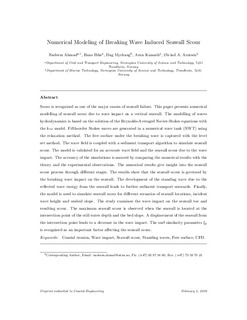| dc.contributor.author | Ahmad, Nadeem | |
| dc.date.accessioned | 2019-04-15T07:22:04Z | |
| dc.date.available | 2019-04-15T07:22:04Z | |
| dc.date.created | 2019-04-11T18:50:44Z | |
| dc.date.issued | 2019 | |
| dc.identifier.issn | 0378-3839 | |
| dc.identifier.uri | http://hdl.handle.net/11250/2594579 | |
| dc.description.abstract | cour is recognised as one of the major causes of seawall failure. This paper presents numerical modelling of seawall scour due to wave impact on a vertical seawall. The modelling of waves hydrodynamics is based on the solution of the Reynolds-Averaged Navier-Stokes equations with the k-ω model. Fifth-order Stokes waves are generated in a numerical wave tank (NWT) using the relaxation method. The free surface under the breaking wave is captured with the level set method. The wave field is coupled with a sediment transport algorithm to simulate seawall scour. The model is validated for an accurate wave field and the seawall scour due to the wave impact. The accuracy of the simulations is assured by comparing the numerical results with the theory and the experimental observations. The numerical results give insight into the seawall scour process through different stages. The results show that the seawall scour is governed by the breaking wave impact on the seawall. The development of the standing wave due to the reflected wave energy from the seawall leads to further sediment transport seawards. Finally, the model is used to simulate seawall scour for different scenarios of seawall locations, incident wave height and seabed slope. The study examines the wave impact on the seawall toe and resulting scour. The maximum seawall scour is observed when the seawall is located at the intersection point of the still water depth and the bed slope. A displacement of the seawall from the intersection point leads to a decrease in the wave impact. The surf similarity parameter is recognised as an important factor affecting the seawall scour. | nb_NO |
| dc.language.iso | eng | nb_NO |
| dc.publisher | Elsevier | nb_NO |
| dc.rights | Attribution-NonCommercial-NoDerivatives 4.0 Internasjonal | * |
| dc.rights.uri | http://creativecommons.org/licenses/by-nc-nd/4.0/deed.no | * |
| dc.title | Numerical modeling of breaking wave induced seawall scour | nb_NO |
| dc.type | Journal article | nb_NO |
| dc.type | Peer reviewed | nb_NO |
| dc.description.version | acceptedVersion | nb_NO |
| dc.source.journal | Coastal Engineering | nb_NO |
| dc.identifier.doi | https://doi.org/10.1016/j.coastaleng.2019.03.010 | |
| dc.identifier.cristin | 1691800 | |
| dc.description.localcode | © 2019. This is the authors’ accepted and refereed manuscript to the article. Locked until 24 March 2021 due to copyright restrictions. This manuscript version is made available under the CC-BY-NC-ND 4.0 license http://creativecommons.org/licenses/by-nc-nd/4.0/ | nb_NO |
| cristin.unitcode | 194,64,91,0 | |
| cristin.unitname | Institutt for bygg- og miljøteknikk | |
| cristin.ispublished | true | |
| cristin.fulltext | postprint | |
| cristin.qualitycode | 2 | |

